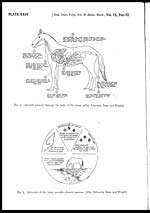Medicine - Veterinary > Veterinary colleges and laboratories > Indian journal of veterinary science and animal husbandry > Volume 9, 1939 > Original articles > Important helminth parasites of horses - their treatment and control
(219) Page 313
Download files
Individual page:
Thumbnail gallery: Grid view | List view

H. D. SRIVASTAVA 313
The infective eggs on being swallowed by a suitable host with grass,
water or dry feed, which has become contaminated with manure, hatch in
the intestine and the liberated larvae burrow into the wall of the gut. They
may pass through into the peritoneal cavity and thence to the liver, but usually
they migrate with the blood stream to this organ. From the liver they are
carried by the blood through the heart to the lungs, where they are arrested
in the capillaries, although some may pass through the arterial circulation and
reach other organs like spleen and kidneys and even the foetus in a pregnant
animal. The majority of larvae escape from the lung capillaries into the
alveoli and finally crawl up the windpipe and are swallowed. On again
reaching the small intestine they settle down and develop to maturity in
eight to ten weeks. The migration through the liver and lungs is completed
in about a week (Plate XXIV).
In heavy infestations the larvae during their course of migration do
considerable damage. Destruction of tissue and haemorrhage may occur
in the liver, but the most important lesions are produced in the lungs, where
the larvae cause numerous small haemorrhages and oedema. Secondary
bacterial invasion of the weakened lung tissue may lead to lobular pneumonia..
Larvae which find their way into the general circulation may cause small
haemorrhages in important organs like brain, myocardium and. kidneys,
though some of the lesions thus caused are probably due to toxins.
When present in large numbers, specially in foals and young horses,
ascarids produce digestive disturbances of various sorts and may cause colic.
Frequently they become entangled with one another, forming large masses
which may cause intestinal obstruction. The entangled mass of worms
may even lead on to a rupture of the wall of the intestine, or the worms may
even perforate the wall of the gut and produce a fatal peritonitis.
Foals usually suffer most from this parasite. In the early stages of
infestation a rise in temperature and cough may be noticed. Later on the
animals become unthrifty with rough, staring coats, but expulsion of the worms
often results in marked improvement in their condition. The worms
liberate toxins which are exceedingly harmful to the host.
The infestation is diagnosed by finding eggs or the worm itself in the
faeces. Carbon di-sulphide is very effective against ascarids in horses. After
fasting the animal for 18 hours, the drug is administered with a stomach
tube or in capsules in a dose of 6 drm. (24 c.c.) per 1,000-lb. body-weight.
The worms are passed for several days after treatment. Purgatives should
not be given as superpurgation may be produced. Fats and oils should be
avoided, for they promote the absorption and increase the toxicity of the
drug. Often the drug produces limited areas of inflammation in the stomach,
but this is of no consequence. Carbon-tetrachloride is also fairly effective,
but oil of chenopodium is not sufficiently effective against this parasite.
The former is given in doses of 6 to 12 drm. (25-50 c.c.) for 1,000-lb. animal.
Though a purgative is not essential, it is advisable to give a saline purgative.
Set display mode to: Large image | Zoom image | Transcription
Images and transcriptions on this page, including medium image downloads, may be used under the Creative Commons Attribution 4.0 International Licence unless otherwise stated. ![]()
| Permanent URL | https://digital.nls.uk/75247093 |
|---|
| Description | Covers articles from 1939. Please note that pagination starts at p.139 and plates at Plate V. |
|---|




